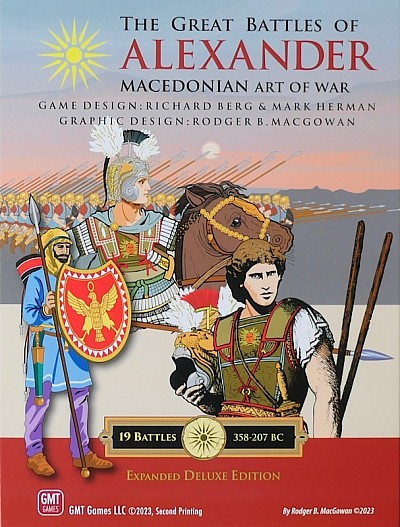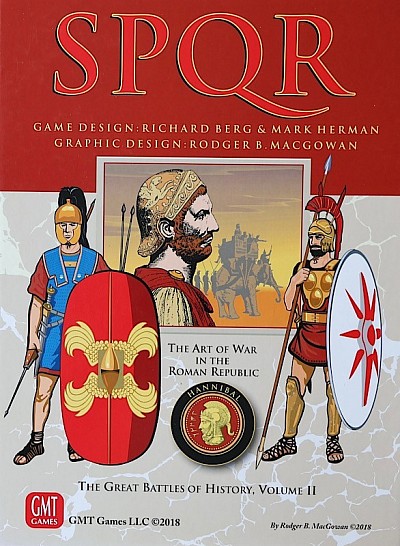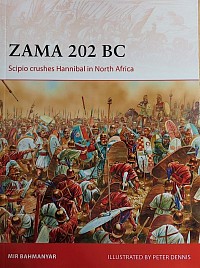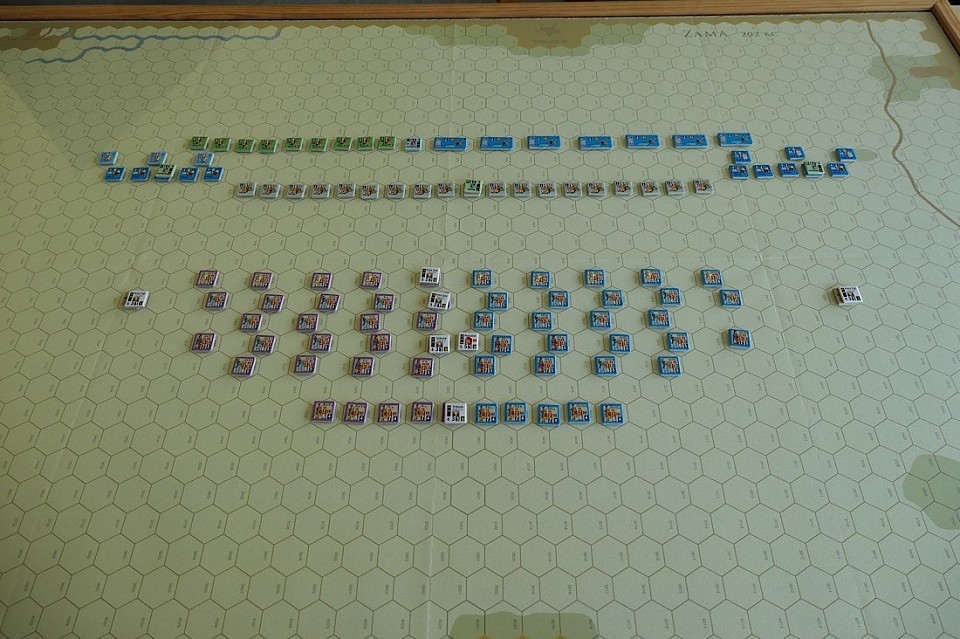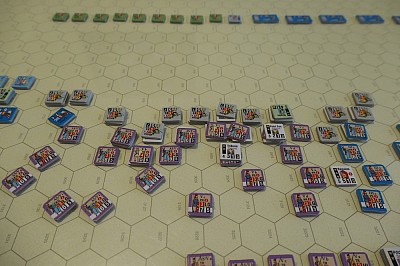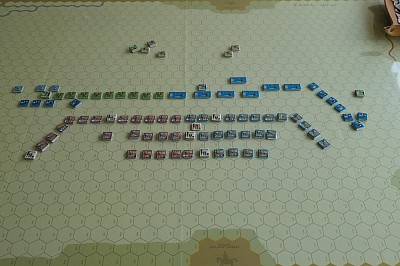Ancients
Great Battles of History module
This is the new reprint of Alexander Deluxe, which is described as expanded and is part of GMT’s Great Battles of History series.
As discussed recently, I have pared down my boardgame collection to mainly just series games and so this will sit with SPQR, giving a lot of battles for just one set of rules.
Alexander alone gives us 19 Battles in total. Each have their own maps and the weighty box comes in with 5½ counter-sheets.
I’m hoping there are some smaller battles in that mix for our face-to-face games, though the system is rated 7 out of 9 (high) for solitaire suitability. I note that when using the ‘Simple Battles’ alternative rulebook, some scenario times are almost cut in half, so I think most of this is going to be playable for me.
The expanded part of this second printing is the Tyrant module, featuring 10 battles between Carthage and Syracuse for control of Sicily 480 - 276 BC.
Expect to see this hitting the table soon!
More Great Battles
This is the Deluxe reprint of SPQR, the second game in the Great Battles of History series. The reprint includes as standard the various modules that were produced for the original SPQR and this expands the number of battles out from the original 5 in the box to 14 expanded by the modules.
The module is concentrating on the Second Punic War and gives us, amongst others, the battles of Trebbia, Cannae and Zama, but the 14 battles range across 280 BC to 109 BC, stretching the period to cover the Battle of Muthul River, with King Jugurtha, the last of the formidable Numidian kings.
As with Alexander, the system rules are quite substantial, but there is a simplified, streamlined version of the rules called 'Simple GBoH' and this is what I intend to use. It works with all of the battles and is formed around just 14 pages of series rules. Each scenario also has its own exclusive, which normally adds a couple of pages onto that, the impact of the simple rules looks like it reduces play time by around 50% in most cases.
A primer for the 2nd Punic War
I quite like to pick up one of the Osprey Campaign books that cover some of my board game titles. The narrative and background of the text compliments the games nicely.
Zama, is a major battle in the SPQR set and the book includes things like weapons, tactics, organisation and the re-telling of the battle story.
The front cover gives a good impression of how the Roman Hastati would have looked in action.
If you click on the cover page to enlarge it, you will notice that two shields on the Carthaginian side have been struck by pilum, which have done their thing of then bending down and causing drag on the shield - nice artistic touch.
Below - the opening set-up for the Bagradas Plains scenario from SPQR (replay below)
Bagradas Plains replay (255 BC)
This SPQR (GMT) scenario is recommended as a ‘beginners’ scenario ….. it will certainly need some skill on the part of the Roman player to pull a win from the situation.
Background - The Romans have been fairly successful fighting the Carthaginians on land and the Roman Consul, Regulus, is pretty keen to have one big engagement that will knock Carthage out of the war.
However, the Carthaginians have secured the service of Spartan’s Xanthipuss and he re-organises the Carthaginian army to a more acceptable level of training.
The set-up immediately invites concern for any Roman player …. they are desperately short of cavalry to protect the wings. Their Alae cavalry are elsewhere, so the few remaining Roman cavalry are outnumbered 8:1.
In addition, the Roman line is initially facing 100 elephants and behind them is a wall of African infantry Phalanx. Historically, the Carthaginian cavalry swept the Roman cavalry away, exposing Roman flanks, while the elephants and phalanx frontal assault shattered the Roman legions.
In my last play, I was finding it difficult, once the lines became mixed, to determine which of the Alae cohorts belonged to the Hastati group and which belonged to the Principes.
While scrolling through posts at Consimworld, I found a most helpful entry. The poster suggested that the Principes should set up on their flip side. The flip side carries a white bar, instantly signifying which units are Hastati and which are Principes.
In the simple version of Great Battles of History, the flip side of the counter is not used in the same way as the original full rules use them. Rather they use the flip side to show which units are not in command when their formation is activated.
This of course is an equally useful administrative function, so now I just use a game marker to show which units are out of command. The single effect of being out of command is that a unit cannot enter or leave an enemy Zone of Control.
The Carthaginian cavalry superiority and the resulting threat to the Roman flanks is certainly a problem for the Romans in this scenario. My solution was to pull the Principes out towards the flanks to meet the cavalry threat, while leaving the Velites and Hastati to deal with the elephant assault.
It turned out that the Romans had done enough to protect their flanks from the cavalry threat, but their front line was ravaged by the elephants.
Phase II
Though taking heavy casualties, the Romans have withstood the initial Carthaginian assault.
The elephants break off the attack and retire. The main line of Phalanx and Celts have to open up to allow the beasts to pass through.
The Romans used this lull to re-organise their army. The battered Hastati fall back and the fresh Principes move up into the front line position. They refuse their flanks as a defence against the threat of Carthaginian cavalry. I very much like the way that this system is allowing proper tactics and army management.
In the Photograph, you can see that the Carthaginian main line has moved forward, ready to engage the Romans. In their rear are the remnants of the elephant corps (for want of a better expression!). The cavalry on the Carthaginian left are well ordered and positioned, ready to support the attack, but on their right, the cavalry wing and light infantry under Hasdrubal have become a little awkwardly placed - they need to sort themselves out!
The dark blue double hex long counters in the Carthaginian line are the North African Phalanx units, the single hex green units are the Celt warriors. The Phalanx blocks are hard hitters, getting a combat bonus for size and generally their Troop Quality factor equals or betters those of the Roman line - though they can be a little awkward to manoeuvre.
And so here we are, at what is essentially Phase II of the battle. The Romans are more than halfway to their breaking point, but I feel that the fresh Principes, now in the front line will not be an easy walkover for the Carthaginians - I am in the middle of this and the outcome is not certain, or at least the Roman side still feel like there is a fight to be had - good!
But, as the Carthaginian attack resumes, the Roman player gets an immediate sense of doom! The African Phalanx units carve into the Roman line, I am shocked at the effectiveness of the attack, though the Phalanx were repeatedly rolling good dice scores ….. but, it was not all going the way of the Carthaginians. On their right, the Celt infantry were taking significant losses and a gap opened in the centre, which the Romans took full advantage of, pouring through and enveloping the phalanx line.
It is a moment of crisis for both sides. The Romans teeter on their breaking point, can they push the Carthaginians over the edge before their own army falls apart?
The Carthaginians attack the Roman right with their cavalry, hoping to quickly bring the Romans to their knees, but their Phalanx units are starting to lose cohesion. The first unit is lost. Loss of these two hex Phalanx counters give double break points, each adding 14 points to the Carthaginian break score.
A second Phalanx is marked with 6 hits, 7 will destroy it, which would take the Carthaginians within 2 break points of losing the game, but the Romans just don’t have the time left to make this happen. It is tight, but they lose two more of their own units, pushing them beyond their own break point (125).
It is all over. Carthage wins, but it is so close.
If just looking at the map, it would be hard to pick a winner, but the break points tell their own tale. The high losses that the Romans suffered on their initial engagement with the elephants, made a comeback difficult, but there was enough hope to make the struggle worthwhile.
The Triarii (final Roman line of defence) have restrictions as to when they can be released and as it happens, those conditions were met in the last turn, so who knows what might of happened if these fresh troops had had a couple of turns to try and turn the tide.
There were three key moments in the game. (1) The initial elephant charge caused carnage in the Roman front rank, though the ‘nellies’ themselves suffered heavy losses (2) the Celts dissolved with surprising speed, leaving a large gap in the Carthaginian centre (3) the final tussle between the Phalanx units and the Roman Principes JUST tipped in favour of the Carthaginians ….. but on another day - who knows!
I must say, this was a brilliant game, the best that I have played in a while, it really drew me in. It went over the four hour mark for play and you definitely need a pair of tweezers to manage the loss markers that all of the units start to carry around in this tightly packed battlefield.
******************************************
The Baetis Campaign 211 BC
For our Friday night game last night, Mike put the Baetis Campaign on the table. This is a three day battle from the Second Punic War presented in the C3i number 37 magazine, which uses the same game engine as Mark Herman’s Gettysburg / Waterloo and Rebel Fury games.
The map is very functional. The dominant terrain feature that you can see is rough ground, which confers a defence bonus to the defender and slows movement. It is a good example of a map that allows a player to better 'read' the battlefield and its signifcant / relevant features.
Having played the system a few times for Horse & Musket games, it felt a little odd doing it with ancients as in my minds eye, the ancient battle is one of organised bodies of units, advancing / defending in line and it is the turning or breaking of the line that is critical. Here individual units have a lot of fluidity when manoeuvring …. however, this is a three day campaign, rather than a single afternoons battle and each turn is representing half a days worth of action and in truth, the engine transfers to the Ancients period rather smoothly and thoughtfully.
The designer has added nuance to get an ancients feel. For example horse have difficulty operating in the presence of elephants, though to my mind, the elephants don’t particularly feel as powerful or significant as they might or offer their erratic contribution to battle (they could become a liability to their own sIde). Perhaps in this time frame, elephants were less of a thing - my knowledge on the subject is too weak to say.
In essence there are two areas of fighting on the map. The photo here shows one of them at the start of play, with the Romans in red and the Carthaginians in blue.
In this part of the battlefield, the Romans made a quick dash for Amtorgis and got it on day 1. At the end of play this was one of the things we wondered whether a different early outcome would have changed the direction of that particular battle area.
To spice things up a bit, the Carthaginians secretly deployed their reinforcement (1 unit) to enter the map in the Roman rear area on this part of the map, to threaten their camp ….. but the Romans responded in a timely fashion (just) and blocked the threat, but it did show the value of distraction with this tactic.
The Romans went on to win in this part of the battlefield and held out in the other part, so overall a clear win for the Romans.
Afterwards we discussed the merits of the game and we both felt that the first game was needed for us to better understand what tactics we should pursue in second playing, so though I think the game will generally run along similar lines on each outing, there is opportunity within the system for each game to remain interesting once you get down amongst the hexes.
In any case, we had enough fun with it to conclude that we would play it again.
Usefully, it is a short game of 5 turns, so it plays to a full conclusion in around 2 hours.
